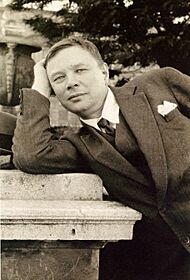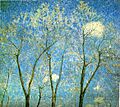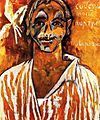Mikhail Larionov facts for kids
Quick facts for kids
Mikhail Larionov
|
|
|---|---|
| Михаил Ларионов | |

Larionov c. 1916–1917
|
|
| Born | June 3, 1881 Tiraspol, Kherson Governorate, Russian Empire
|
| Died | May 10, 1964 (82) |
| Nationality | Russian |
| Education |
|
| Known for | Painting, costume design, illustrator, set designer |
Mikhail Fyodorovich Larionov (Russian: Михаи́л Фёдорович Ларио́нов; June 3, 1881 – May 10, 1964) was an important Russian painter. He was known for his new and bold ideas in art, helping to create the first type of abstract art in Russia. Abstract art uses shapes, colors, and lines instead of showing things as they look in real life. Mikhail Larionov's partner for life was another famous artist, Natalia Goncharova.
Contents
Mikhail Larionov's Early Life and Art Journey
Mikhail Larionov was born in a place called Tiraspol, which was part of the Russian Empire back then. In 1898, when he was 17, he started studying art at the Moscow School of Painting, Sculpture and Architecture. His teachers included famous artists like Isaac Levitan and Valentin Serov. Mikhail had very strong and new ideas about art, which sometimes got him into trouble. He was even suspended from school three times!
In 1900, he met Natalia Goncharova, who was also an artist with fresh ideas. They became partners for life, sharing their passion for art.
From Impressionism to New Art Styles
Around 1902, Larionov started painting in a style called Impressionism. This style uses small, thin brushstrokes to show how light changes things. After visiting Paris in 1906, his art changed. He moved to Post-Impressionism, which used brighter colors and bolder brushstrokes.
Later, he developed a style called Neo-primitive. This style was inspired by simple, traditional Russian folk art, like the bright pictures found on signs.
Art Exhibitions and Groups
Mikhail Larionov loved to show new and exciting art. In 1908, he organized an exhibition in Moscow called the Golden Fleece. It featured paintings by famous international artists like Henri Matisse, André Derain, Georges Braque, Paul Gauguin, and Vincent van Gogh. He also helped show the work of other Russian artists such as Vladimir Tatlin, Marc Chagall, and Kazimir Malevich.
Larionov helped start two important Russian art groups. The first was called Jack of Diamonds (active from 1909 to 1911). The second, even more daring group, was called Donkey's Tail (active from 1912 to 1913). He even gave both groups their names! In 1911, he had his very first solo art show in Moscow, which lasted only one day. He was also inspired by the Georgian artist Niko Pirosmani.
Creating Rayonism and Moving to France
Mikhail Larionov was influenced by a style called Cubo-Futurism, which combined sharp angles and movement. In 1913, he and Natalia Goncharova created their own art style called Rayonism. This was a very important step because it was the first time nearly abstract art was created in Russia. Rayonism focused on showing light rays and colors, making art that didn't look like real objects.
In 1915, Larionov left Russia. He went to Paris, France, and started working with a famous ballet owner named Sergei Diaghilev. He designed costumes and sets for the Ballets Russes, a very famous dance company. Mikhail Larionov lived the rest of his life in France and became a French citizen. He passed away in 1964, at the age of 82, in a suburb of Paris called Fontenay-aux-Roses.
Remembering Larionov
In 2001, the Central Bank of Transnistria (where he was born) made a silver coin to honor Mikhail Larionov. This coin was part of a special series called The Outstanding People of Pridnestrovie.
His paintings are very valuable. One of his artworks sold for 2.2 million British pounds at an auction. He is considered a "world famous artist" and is buried in Ivry Cemetery in France.
Images for kids
See also
 In Spanish: Mijaíl Lariónov para niños
In Spanish: Mijaíl Lariónov para niños
- List of Russian artists






